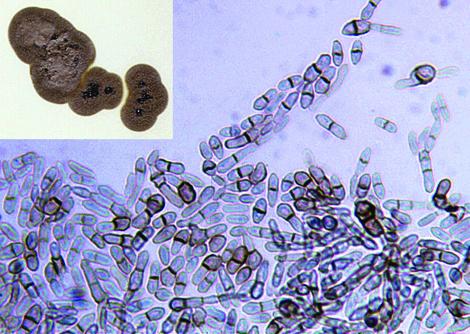Hortaea werneckii
Synonyms:
Cladosporium werneckii; Exophiala werneckii; Phaeoannellomyces werneckii.
Hortaea werneckii is a common saprophytic fungus believed to occur in soil, compost, humus and on wood in humid tropical and subtropical regions and is the causative agent of tinea nigra in humans.
RG-1 organism.

Conidia of Hortaea werneckii
Morphological description:
Colonies are slow growing, initially mucoid, yeast-like and shiny-black. However with age they develop abundant aerial mycelia and become dark olivaceous in colour. Microscopically, colonies consist of brown to dark olivaceous, septate hyphal elements and numerous two-celled, pale brown, cylindrical to spindle-shaped yeast-like cells that taper towards the ends to form an annellide. Most yeast-like cells also have prominent darkly-pigmented septa. Annellides may also arise from the hyphae. Conidia are one to two-celled, cylindrical to spindle-shaped, hyaline to pale brown and usually occur in aggregated masses. Chlamydospores also present.
Key features:
Hyphomycete, two-celled yeast-like cells producing annelloconidia.
Molecular identification:
An ITS-primer specific for H. werneckii was developed by Abliz et al. (2003). ITS sequencing can also assist identification.
References:
Mok (1982), McGinnis (1980), McGinnis et al. (1985), Rippon (1988), de Hoog et al. (2000), Abliz et al. (2003), Ng et al. (2005).
| Antifungal susceptibility: Hortaea werneckii (Australian national data); MIC µg/mL | |||||||||||||
|---|---|---|---|---|---|---|---|---|---|---|---|---|---|
| No | ≤0.03 | 0.06 | 0.125 | 0.25 | 0.5 | 1 | 2 | 4 | 8 | 16 | 32 | ≥64 | |
| AmB | 7 | 1 | 1 | 1 | 2 | 2 | |||||||
| FLU | 7 | 2 | 1 | 4 | |||||||||
| VORI | 7 | 2 | 1 | 3 | 1 | ||||||||
| POSA | 5 | 2 | 2 | 1 | |||||||||
| ITRA | 9 | 2 | 2 | 2 | 3 | ||||||||
